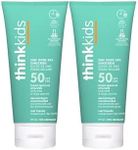Buying Guide for the Best Natural Sunscreen For Kids
Choosing a natural sunscreen for kids is an important decision because children's skin is more sensitive and can react more easily to harsh chemicals. Natural sunscreens use mineral-based ingredients to provide protection, making them a popular choice for parents who want to avoid synthetic chemicals. When picking a sunscreen, it's important to look at the ingredients, the level of sun protection, how easy it is to apply, and whether it stays on during activities like swimming or sweating. Understanding the key features will help you select a sunscreen that keeps your child safe and comfortable outdoors.Active IngredientsActive ingredients in natural sunscreens are usually minerals like zinc oxide or titanium dioxide. These minerals sit on top of the skin and physically block the sun’s rays, rather than being absorbed. This is important because mineral sunscreens are less likely to cause irritation or allergic reactions, making them safer for kids. When comparing products, look for those that list zinc oxide or titanium dioxide as the main active ingredients, and avoid chemical filters like oxybenzone or avobenzone if you want a truly natural option. If your child has very sensitive skin, zinc oxide is often considered the gentlest choice.
SPF RatingSPF stands for Sun Protection Factor and measures how well the sunscreen protects against UVB rays, which cause sunburn. For kids, an SPF of 30 to 50 is generally recommended. Lower SPF (15-30) offers less protection and may be suitable for short periods outdoors, while higher SPF (50+) provides more coverage for longer exposure or very fair skin. Think about how long your child will be outside and how easily they burn when choosing the right SPF.
Water ResistanceWater resistance tells you how long the sunscreen will stay effective when your child is swimming or sweating. Labels usually indicate 40 or 80 minutes of water resistance. If your child will be playing in water or sweating a lot, choose a sunscreen with higher water resistance. For mostly dry activities, this feature is less critical, but still helpful for active kids.
Ease of ApplicationNatural sunscreens can come in creams, lotions, sticks, or sprays. Creams and lotions are easy to spread but may leave a white cast due to the minerals. Sticks are convenient for faces and small areas, while sprays are quick but can be harder to apply evenly. If your child dislikes certain textures or you need to apply sunscreen quickly, consider which form will be easiest for you and your child to use regularly.
Additional IngredientsBesides the main sun-blocking minerals, natural sunscreens may include plant-based oils, butters, or extracts for moisturizing and soothing the skin. These can be helpful for kids with dry or sensitive skin, but if your child has allergies, check the ingredient list for potential triggers. Fragrance-free formulas are often best for sensitive skin.
Broad Spectrum ProtectionBroad spectrum means the sunscreen protects against both UVA and UVB rays. UVA rays can cause long-term skin damage, while UVB rays cause sunburn. Always choose a sunscreen labeled as broad spectrum to ensure your child is protected from both types of harmful rays, especially during long periods outdoors.















